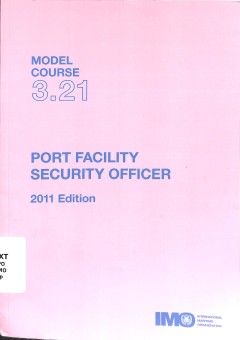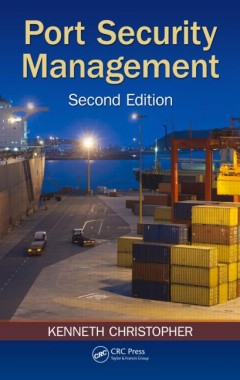Ditapis dengan

A plastic hull in tough marine service
THERE ARE NO alongside wharves for ocean-going vessels at Aden, so all cargo handling is done by tugs, lighters, launches and similar vessels. The conditions in which these craft work are quite severe and include shell encrustation, marine plant growth, and turbulent sea-water. Some craft operate both inshore and some miles out where they meet quite heavy seas. Maintenance work and costs are he…
- Edisi
- -
- ISBN/ISSN
- -
- Deskripsi Fisik
- 1 halaman
- Judul Seri
- A plastic hull in tough marine service
- No. Panggil
- ATC PO ADE a

Portfolio of port-centric supply chain disruption threats
Purpose –This study provides a risk assessment of port-centric threats that may have adverse effects on supply chain continuity from the perspectives of port operators and port users, thereby determining the significance of these threats to supply chain disruptions. Design/methodology/approach – Drawing on literature review and reported cases, 19 port-centric disruptive events were identi…
- Edisi
- International Journal of Logistics Management, The
- ISBN/ISSN
- -
- Deskripsi Fisik
- 28 halaman
- Judul Seri
- Article information
- No. Panggil
- ATC PO HUI a

Location of regional and international hub ports in liner shipping
Purpose – This paper aims to investigate the location of regional and international hub ports in liner shipping by proposing a hierarchical hub location problem. Design/methodology/approach – This paper develops a mixed-integer linear programming model for the authors’ proposed problem. Numerical experiments based on a realistic Asia-Europe-Oceania liner shipping network are carried out t…
- Edisi
- Maritime Business Review
- ISBN/ISSN
- -
- Deskripsi Fisik
- 13 halaman
- Judul Seri
- Location of regional and international hub ports in liner shipping
- No. Panggil
- ATC PO JIA a

Maritime Business Review
Purpose – This study aims to develop an assessment methodology using a Bayesian network (BN) to predict the failure probability of oil tanker shipping firms. Design/methodology/approach – This paper proposes a bankruptcy prediction model by applying the hybrid of logistic regression and Bayesian probabilistic networks. Findings – The proposed model shows its potential of contributing to…
- Edisi
- Maritime Business Review
- ISBN/ISSN
- -
- Deskripsi Fisik
- 23 halaman
- Judul Seri
- Application of Bayesian networks in analysing tanker shipping bankruptcy risks
- No. Panggil
- ATC PO GRA a

Port facility security officer
The purpose of the IMO model courses is to assist maritime training institutes and their teaching staff in organizing and intoducing new training courses, or in enhanching, updating or supplementing exiting training material where the quality and effectiveness of the training courses may thereby be improved.
- Edisi
- 2011 Edition
- ISBN/ISSN
- 978-92-801-1540-6
- Deskripsi Fisik
- vii, 64 p., 33 cm
- Judul Seri
- Model Course 3.21
- No. Panggil
- TXT PO IMO p

Security awareness training for all port facility personnel
This model course is intended to provide the knowledge required to enable personnel without designated security duties in connection with a Ship Security Plan (SSP) to enhance ship security in accordance with the requirements of chapter XI-2 of SOLAS 74 as amended, the ISPS Code, and section A-VI/6-1 of the STCW Code, as amended. Those who successfully complete this course should achieve the re…
- Edisi
- 2011 Edition
- ISBN/ISSN
- 978-92-801-4247-1
- Deskripsi Fisik
- v, 50 pg., 33 cm
- Judul Seri
- Modul Course 3.25
- No. Panggil
- TXT PO IMO s

Port security management
Sea and freshwater ports are a key component of critical infrastructure and essential for maintaining global and domestic economies. In order to effectively secure a dynamic port facility operation, one must understand the business of maritime commerce. Following in the tradition of its bestselling predecessor, Port Security Management, Second Edition continues to supply read…
- Edisi
- Second Ed.
- ISBN/ISSN
- 978-1-4665-9163-9
- Deskripsi Fisik
- xx, 356 p., 23 cm
- Judul Seri
- -
- No. Panggil
- PO CHR p

Process reengineering in port operations : a case study
In the age of globalization, seaports play a vital role in connecting national supply chains to the global marketplace. Improving port operations has become a priority for many countries. One of the ways to achieve this objective is process reengineering. This paper reviews the IT‐enabled reengineering process at Pusan Port, South Korea. The paper examines the issues and problems leading to p…
- Edisi
- Vol. 11 Iss 2 pp. 59 - 72
- ISBN/ISSN
- -
- Deskripsi Fisik
- 16 pages
- Judul Seri
- -
- No. Panggil
- ATC PO PAI p
 Karya Umum
Karya Umum  Filsafat
Filsafat  Agama
Agama  Ilmu-ilmu Sosial
Ilmu-ilmu Sosial  Bahasa
Bahasa  Ilmu-ilmu Murni
Ilmu-ilmu Murni  Ilmu-ilmu Terapan
Ilmu-ilmu Terapan  Kesenian, Hiburan, dan Olahraga
Kesenian, Hiburan, dan Olahraga  Kesusastraan
Kesusastraan  Geografi dan Sejarah
Geografi dan Sejarah